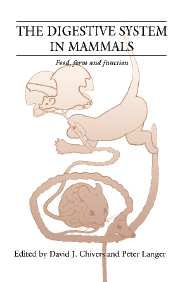Book contents
- Frontmatter
- Contents
- List of contributors
- Preface
- Part I Introduction
- 1 Gut form and function: variations and terminology
- 2 Food and digestion of Cenozoic mammals in Europe
- 3 Modelling gut function: an introduction
- 4 Optimum gut structure for specified diets
- Part II Food
- Part III Form
- Part IV Function
- Part V Synthesis and perspectives
- Index
3 - Modelling gut function: an introduction
Published online by Cambridge University Press: 18 March 2010
- Frontmatter
- Contents
- List of contributors
- Preface
- Part I Introduction
- 1 Gut form and function: variations and terminology
- 2 Food and digestion of Cenozoic mammals in Europe
- 3 Modelling gut function: an introduction
- 4 Optimum gut structure for specified diets
- Part II Food
- Part III Form
- Part IV Function
- Part V Synthesis and perspectives
- Index
Summary
A cautious man should above all be on his guard against resemblances: they are a very slippery sort of thing.
Plato (in Gordon et al. 1972)Digestive physiologists either focus narrowly, use a reductionist approach and work at the cellular, biochemical and molecular levels, or analyse digestive performance (measured usually as digestive efficiency and retention time of food in the gut) at the whole organism level. Consequently digestive physiology encompasses two more or less exclusive bodies of data: on one hand we have adequate knowledge of the molecular and biochemical characteristics of digestive enzymes and nutrient transport systems (Desnuelle et al., 1986); on the other we have a large catalogue of retention times, assimilation efficiencies and digestive morphologies for a variety of animal tax a fed on an assortment of food types (e.g. Chivers and Hladik, 1980; Warner, 1981; Karasov, 1990). A consequence of the slightly schizophrenic nature of the trade is that we know very little about how the fine details of nutrient digestion and uptake function are integrated to affect whole organism digestive efficiency andrTood intake rates. Until very recently, digestive physiology has lacked a theoretical framework that integrates digestive processes with gut morphology and the chemical properties of food. Because nutrient assimilation is a remarkably complex phenomenon involving a variety of enzymatic and transport pathways that take place in a variety of organs within the gastro- intestinal tract, it is perhaps not surprising that attempts to analyse digestion from an integrated perspective have been few (Sibly, 1981).
Mertens and Ely (1982) and Illius and Gordon (1992), for example, have developed detailed mathematical models that integrate intake, digestion and food characteristics for ungulates.
Information
- Type
- Chapter
- Information
- The Digestive System in MammalsFood Form and Function, pp. 25 - 53Publisher: Cambridge University PressPrint publication year: 1994
Accessibility standard: Unknown
Why this information is here
This section outlines the accessibility features of this content - including support for screen readers, full keyboard navigation and high-contrast display options. This may not be relevant for you.Accessibility Information
- 12
- Cited by
